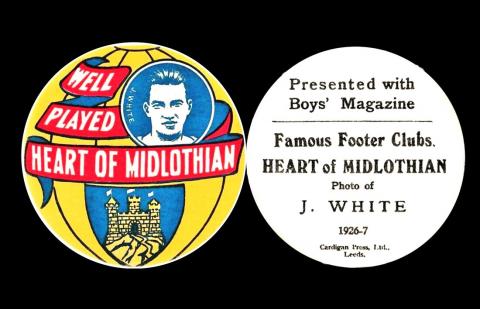
This club was simply formed by a few friends who had connections with the Heart of Midlothian Quadrille Assembly Club, a social and dance club in Edinburgh. It seems that some time in the 1870s some of the male members got a bit bored with the dancing and one of them brought a football with them, with which they adjourned to a local piece of open ground. At that time, of course, it was simply a kick about, with very improvised rules. We know that the group was in existence by December 1873 though, because in that month what is thought to be the first ever game of proper "Association" Football was held in Edinburgh, and after that our little group adopted many of the rules, and also gave themselves a team name, "Heart of Midlothian", reportedly after Sir Walter Scott`s novel - though there was also a cricket club, to which some of the members also belonged, and that was already called by the same name.
In 1875, the team believed themselves good enough to apply to join the Scottish Football Association, and they were accepted. In fact they made the final of the Scottish Cup later in the same year, against a team fielded by the third Edinburgh Rifle Volunteers. It ended in a goal-less draw, as did the rematch. There was controversy in 1884, after they won the Scottish Cup against Dunfermline with the massive rout of 11 goals to one - after which there were protests that their team included professional footballers. And they must have been, for they were suspended from the Scottish Football Association, for two years. After that, though, they returned, and won four cups between 1891 and 1906.
You can read their entire history at the club`s homepage, and it, too, is currently being updated with loving care.
The player in the inset is Jock White, who was born in Coatbridge on the 27th of August 1897 and not only played for Albion Rovers and Heart of Midlothian within his native Scotland, but also went across the border and played for Leeds United. His claim to fame was that in 1926, the year this card was issued, he had actually had a run of scoring four goals in three successive matches. And he also represented his Country, with the Scottish National Team.
His three brothers also played football at a similarly high level, Willie for Hamilton Academicals and Southampton - Tom for Heart of Midlothian and Alloa Athletic - and Jimmy for Albion Rovers, Motherwell, and also played in the United States, for the Marksmen, of New York.
"Boy`s Magazine" was published by Allied Newspapers Ltd, a British company which eventually had control of many local and national titles, including Amalgamated Press, which they acquired in 1926. But it started with two Welsh brothers, Gomer and William Berry, in 1915, buying out the Sunday Times. Along the way they met Edward Iliffe, who ran the Birmingham Post, the Birmingham Mail, the Cambridge Daily News and the Coventry Evening Telegraph
The first edition of "Boy`s Magazine" hit the newsstands on the 27th of February 1922, billed as a "New magazine of Sport and Adventure". It cost 2d. and was issued every Monday. And that first issue also included a free gift, which appears on the cover as "Art Plate of Famous Football Team Inside - suitable for framing."
As for our card, this is a most attractive set, very similar to Baines and often confused with them. Our original British Trade Index volume one, issued in 1962, catalogues it as :
- FAMOUS FOOTER CLUBS. Shaped and die cut. Blue, red and yellow. Dated 1926-7. Unnumbered. (21 known) ... BPM-4
Arsenal
Birmingham
Bolton Wanderers
Burnley
Cardiff City
Celtic
Chelsea
Clapton Orient
Everton
Fulham
Leeds United
Liverpool
Manchester City
Manchester United
Partick Thistle
Portsmouth
Preston N.E
Sheffield United
Spurs
Sunderland
Swansea
You will notice straight away that our card is not there. And it did not appear in the second volume either. In fact it took until the third volume to be added, as :
- BPM-4 (Famous Footer Clubs). Add Aston Villa, Heart of Midlothian, West Ham United.
When all these four volumes were collated, and formed into our updated British Trade Index, one volume and a handbook uniform, the entry had slightly changed. That reads :
- FAMOUS FOOTER CLUBS. 1926-27. Shaped and die cut. Blue, red and yellow. Unnd. (24). Issued two each week for 12 weeks. See HB-144. ... BOY-460.
